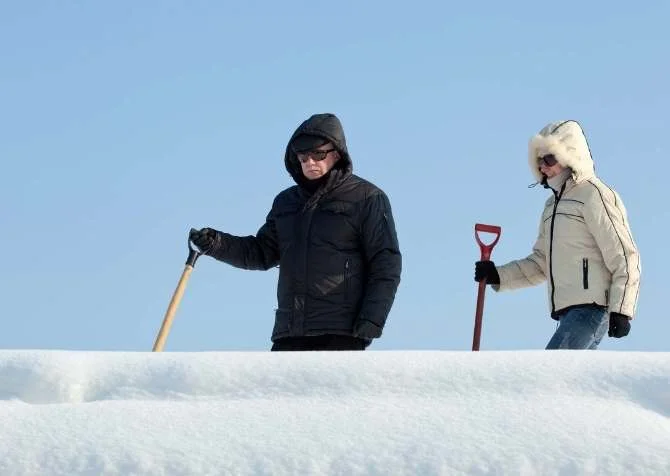Should I Remove Snow From My Roof
Snow can be beautiful, but it can also cause problems on your roof. Not only does the snow weight down the roof and make it more likely to collapse under that pressure, but if not removed properly then your roof could become frosted or icicles could form and fall off -- both of which are dangerous. Although roofs are designed to withstand heavy loads of snow, it's essential that you routinely remove snow from your roof to prevent mishaps.
There are two schools of thought on clearing your roof. Some people advocate clearing the snow to make sure that there is no moisture left, while others say that clearing it can cause water damage and ice dams. Which one you do depends on where you live, what materials your roof is made of, how much time you want to spend clearing off your roof, and whether or not you are willing to take the risk of clearing it.
How To Remove Snow From Roof
When clearing snow from your roof, most people advocate using a roof rake. This is usually sufficient for clearing the larger chunks of snow that have built up on the surface of your roof, but won't help you clear the smaller stuff. If clearing off large chunks of snow isn't clearing all the snow, you can use a shovel to get rid of what's left.
Make sure that when clearing the roof, you start from one side and work your way across so that there is less chance for falling or slipping on ice while clearing it.

Once you've removed the large chunks, use a soft-bristle brush to gently move across the roof again, clearing off any small chunks of snow that are left. All in all, clearing your roof is an important task to make sure your home doesn't collapse under the weight of the snow -- just be aware of how long you're willing to spend clearing the roof and what kind of risk you're willing to take on clearing it before starting.
Signs When You Should Worry
Excessive loads on residential and buildings due to accumulated snow can weaken the structural integrity of your roof. It can also cause blocked gutters, plumbing problems, cracks that allow water to seep into your home, or worst, cause the roof to collapse, especially on older buildings.
This is why it's crucial that you routinely check and consult a roofing specialist and get a professional opinion. A comprehensive roof inspection and consultation will give you more detail on your roof's condition and help prevent unnecessary roof damage and cost. Read more to know when it's time to shovel the snow off your roof.

Flat or Low-Pitch Roof
A roof pitch is the measure of the slant of your roof and is one of the most important things to consider when building or replacing a new roof, especially if you live in a snowy climate. Understanding your roof's design and its purpose for health and safety is essential.
However, roof experts conclude, flat and low-pitched roofs are more susceptible to snow accumulations and at greater risk of buckling. Remember, the higher the roof pitch, the easier the snow slides off.
Recent heavy snowfall
Clear a massive amount of snow that accumulated for a few days after a steady snowfall or winter snow. Most of the roof warranties suggest snow should be cleared off the roof before it reaches a depth of 2'. However, experienced snow removal contractors suggest sticking to the 6 inches of snowfall to prevent ice dams. Bear in mind that fresh snow that has just fallen is the easiest snow to remove from your roof.
Massive snow load on your roof
Fresh snow weighs 5 pounds per square foot, while packed snow weighs more. This means old and new snow combined can exceed load capacity. Again this depends on your roof style, structure, and age, but most roofs can withstand 20 pounds per square foot of snow. When in doubt, it's recommended to check local building codes to verify or speak to a roofing specialist.
Your home begins to make weird sounds
Look for signs. Your home will start sending out "calls for help," such as cracking, sagging ceiling, popping or cracking noises, as well as jammed doors and windows. These are a sure sign that your roof is overstressed and needs help!
Ice Dams inside your home
Keep an eye on your ceiling! Have you noticed cracks in your wall or water spots on your ceiling? Ice dams are ice build-up around the edge of your roof. These icy blockages can bring down gutters, peel off your shingles and put downspouts at risk too. It can also cause interior damage and leak into your house that may trigger roof collapse.
Call a roofing specialist for help!
Removing snow and ice dams should be done by professionals. Most homeowners may opt to save money and remove the snow build-up all by themselves. However, it's a bit more complicated than what it looks like. Snow removal takes special equipment, experience, and training.
If you have the knowledge and expertise, of course, you can. Though it may look easy, you still need to consider a few things when removing snow loads.
Final Thoughts
Attempting to remove snow is more hazardous than beneficial. Getting an experienced service is the best course of action than damaging your roof any further and risk of personal injury, including fatality. Keep your roof in excellent condition all through the colder months to get the protection you and your family need from harsh weather and the elements. Trust the experts when they say you should never go onto a roof alone. Get all your questions answered today!